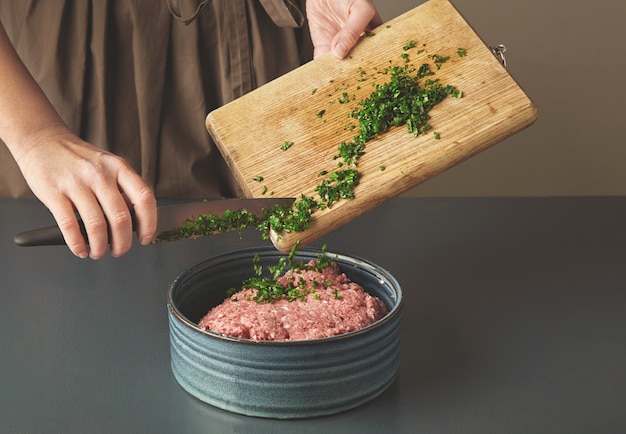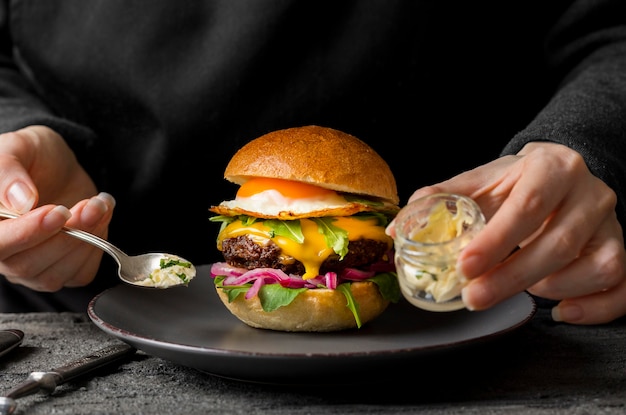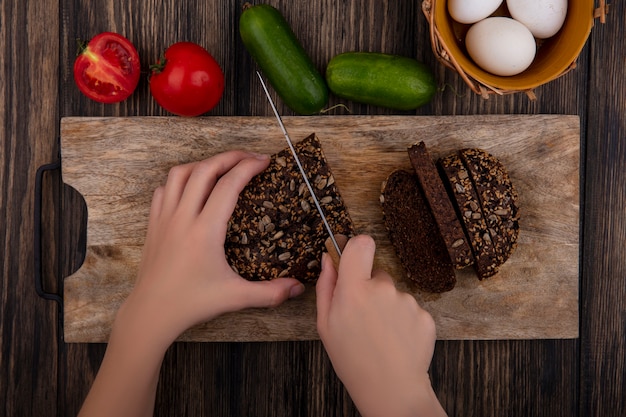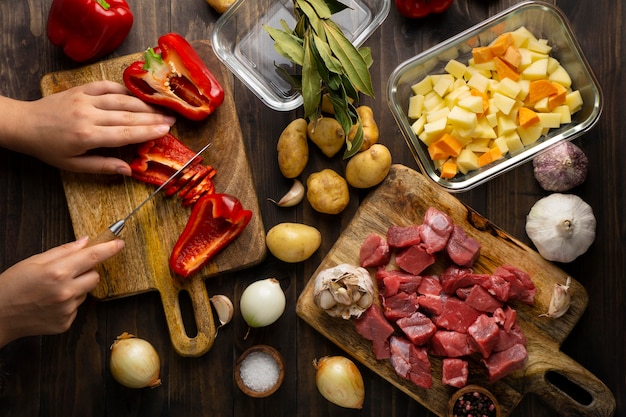Right, let's talk burgers. You know the drill: bun, cheese, maybe some pickles and onions, and then, of course, the star of the show, the burger patty. But getting that patty just right, juicy and perfectly cooked, that's where the real skill comes in. It's not just about chucking it on the grill and hoping for the best. It's about timing, temperature, and, dare I say, a bit of intuition. And trust me, I've been through the ringer with burgers, from dry, overcooked disasters to patties that were so raw they'd make a vegetarian think twice. But after countless experiments (and a fair few burnt fingers), I've finally cracked the code to the perfect burger patty.
This guide is your roadmap to burger nirvana. We'll delve into the different types of meat, how to shape your patties, the best grilling techniques, and of course, the holy grail – determining the perfect cooking time. So, grab your spatula, fire up the grill, and get ready to learn the secrets of burger perfection.
(Part 1) The Meat Matters

Let's start with the heart of the burger: the meat. Now, I'm a firm believer that you can't beat a good old-fashioned beef patty. It's classic, it's delicious, and it's packed with flavour. But that doesn't mean you have to stick to just beef. There's a whole world of burger possibilities out there, from juicy lamb patties to flavourful turkey burgers, and even vegetarian alternatives. Ultimately, it all boils down to your personal preference.
Beef: The Classic Choice
When it comes to beef, you've got a few options. If you want a rich, intense flavour, go for a beef blend with a higher fat content like 80/20. This will give your burger a juicier, more tender bite. If you prefer leaner, you can opt for 90/10 or even 93/7, but be aware that they might be a bit drier. Personally, I'm a sucker for a good, juicy 80/20 patty. It's just got that perfect balance of flavour and tenderness. I remember one time, I tried a 93/7 patty and it was so dry, it felt like I was chewing on a piece of cardboard. Never again!
Now, here's a little secret that'll change your burger game: grind your own beef. It's a bit more work, but the flavour difference is phenomenal. You can control the fat content and the texture of the meat, resulting in a patty that's juicier and more flavorful than anything you'll find pre-ground. Just make sure you use a good quality cut of beef, like chuck or sirloin. I usually use a blend of chuck and sirloin for the perfect balance of fat and lean. You can even experiment with different cuts, like short rib or brisket, for a richer flavour profile. But keep in mind, the higher the fat content, the juicier your patty will be.
Beyond Beef: Exploring Alternatives
But let's not forget the other amazing options out there. Lamb, for example, brings a unique, earthy flavour to the table, while turkey offers a lighter, leaner alternative. Chicken can also be a great choice, especially if you're looking for a less greasy option. Just make sure to use ground chicken that's specifically intended for burgers, as it tends to be a bit more tender. And if you're vegetarian, you're in luck! There are some incredible veggie burgers on the market these days, made from everything from lentils and quinoa to mushrooms and chickpeas. Just don't go for the frozen kind - those are usually full of fillers and lack the real flavour of a homemade patty.
For a truly unique vegetarian burger experience, try making your own patty. You can find tons of recipes online for black bean burgers, lentil burgers, and even mushroom burgers. These homemade veggie patties often use spices like cumin, paprika, and chili powder, adding a depth of flavor that you won't find in store-bought options. Just remember to bind the ingredients well, so your patty holds together on the grill.
(Part 2) Shaping Up Your Patty

Now that we've chosen our meat, it's time to shape our patty. This might seem like a simple step, but it actually plays a crucial role in how your burger cooks.
The Perfect Patty: A Guide to Shaping
Here's the deal: you want your patty to be slightly wider than the bun, around 1/2-inch thick, and a bit rounded on the edges. Why? Because this shape ensures even cooking and allows the juices to be trapped in. When you're shaping your patties, don't overwork the meat. Just gently press it into your desired form. And remember, the less you handle it, the better. You want the patty to stay nice and tender, not dense and chewy.
You can use a burger press to create perfectly uniform patties, which is especially helpful if you're making a large batch. However, if you're just making a few burgers, you can easily shape them by hand. Just use your hands to form a flat disc of meat, then gently press down on the center to create a slight indentation. This indentation will help to prevent the patty from puffing up too much during cooking.
Pro Tips for Perfect Patties:
- Use a meat thermometer to ensure your patties are at least 160°F (71°C) before serving. This ensures they're cooked through and safe to eat.
- Form a small indentation in the center of your patties. This helps them cook more evenly and prevents them from puffing up too much.
- Season your patties generously. Salt and pepper are the staples, but feel free to experiment with other spices like garlic powder, onion powder, or smoked paprika.
- Don't forget the "secret ingredient" – a little bit of butter. Adding a small pat of butter to the top of each patty just before grilling will add a touch of richness and flavour.
- Don't be afraid to get creative with your patty shape. If you're feeling adventurous, try making a patty in the shape of a heart or a star. You can even add a little bit of cheese to the center of the patty before shaping it, creating a "cheese-stuffed" burger.
(Part 3) Grilling Time: The Art of the Sizzle

Right, let's talk grilling. This is where the real magic happens. But before we get into the actual cooking, we need to make sure we're set up for success.
Setting the Stage for a Perfect Grill
First things first, preheat your grill. If you're using a gas grill, aim for medium-high heat (around 400-450°F or 200-230°C). If you're using a charcoal grill, get those coals nice and hot, and make sure there are some good, hot embers. Once your grill is ready, clean the grates with a wire brush. You want those grates nice and clean to prevent your patties from sticking.
Remember, the key to grilling a perfect burger is to cook it over high heat for a short amount of time. This creates a nice sear on the outside, while keeping the inside juicy and tender. If you cook your burger over low heat for too long, it will dry out and become tough.
Grilling Techniques: From Beginner to Pro
Now, there are a few different techniques you can use when grilling your burgers. The most common one is direct grilling, where you place the patties directly over the heat. This is great for achieving a nice sear and char on the outside. Another option is indirect grilling, where you move the patties to a cooler part of the grill. This is best for cooking thicker patties or if you want to avoid overcooking the outside.
And then there's the "reverse sear" technique, which involves cooking your patties over low heat until they reach an internal temperature of 130°F (54°C) and then finishing them over high heat to sear the outside. This method produces a juicy, perfectly cooked burger.
For those of you with a gas grill, try using the "two-zone" method. This involves setting one side of the grill to high heat and the other side to low heat. You can then cook your burgers over high heat for a few minutes to sear them, then move them to the low heat side to finish cooking. This helps to prevent overcooking the patties and allows you to cook them more evenly.
(Part 4) The Ultimate Time Guide: Finding Your Sweet Spot
So, we're finally here: the moment of truth. Determining the perfect cooking time for your burger patty. Now, I'm not going to lie to you, it's not an exact science. But with a little practice, you'll get the hang of it. Here are some general guidelines to get you started, but remember, always use a meat thermometer to ensure your patty is cooked to your liking.
Time and Temperature: A Guide for Perfect Burgers
Here's a breakdown of the average cooking times based on patty thickness:
| Thickness (inches) | Cooking Time (minutes per side) |
|---|---|
| 1/2-inch | 3-4 minutes per side |
| 3/4-inch | 4-5 minutes per side |
| 1-inch | 5-6 minutes per side |
Remember, these are just averages. The actual cooking time will vary depending on the heat of your grill and the type of meat you're using. For example, thinner patties will cook faster than thicker ones, and leaner meats will take longer to cook through. Ultimately, you need to watch your burgers closely and use a meat thermometer to ensure they're cooked to your liking.
Don't Overcook! Signs of a Perfect Burger
One of the biggest mistakes people make is overcooking their burgers. Overcooked burgers are dry, tough, and flavorless. You want your burger to be cooked through but still juicy and tender.
Here are some signs to look for that indicate your burger is ready:
- The patty is firm to the touch and springs back when you press it.
- The juices run clear, not pink, when you poke it.
- The patty has a nice brown crust on the outside.
Using a Meat Thermometer: A Culinary Hero
Don't be afraid to use a meat thermometer. It's your best friend when it comes to cooking burgers. It takes the guesswork out of the equation and ensures that your patty is cooked to your desired level of doneness. I always use a meat thermometer, and it's saved me from countless overcooked burgers. It's a small investment that pays off big time. Just make sure to insert the thermometer into the thickest part of the patty, avoiding bone or fat.
For a more accurate reading, use an instant-read thermometer. This type of thermometer gives you a quick and accurate temperature reading, allowing you to check your burgers without having to open the grill lid too often. And remember, you don't need to cook your burgers to a well-done temperature. If you prefer your burgers medium-rare or medium, that's perfectly fine! Just make sure to use a meat thermometer to ensure the burger is cooked to your liking.
(Part 5) Beyond the Grill: Other Cooking Methods
While grilling is the classic method for cooking burgers, there are plenty of other options out there. Sometimes, you just don't have access to a grill, or you're simply in the mood for something different. So, let's explore some alternative cooking methods.
Pan-Frying: A Simple and Delicious Option
Pan-frying is a great way to cook burgers if you don't have a grill. Simply heat a heavy-bottomed pan over medium-high heat and add a little oil. Then, place your patties in the pan and cook for 3-4 minutes per side, or until they're cooked to your liking. You can even use a cast iron skillet to get that delicious sear. I love using a cast iron skillet because it retains the heat so well, resulting in crispy edges and a perfectly cooked patty. Just remember to season it properly before using it.
To ensure even cooking, you can use a splatter screen to protect yourself from hot grease splatters. Another helpful tip is to add a few tablespoons of water to the pan after the patties have been cooking for a few minutes. The steam will help to create a more moist patty and prevent it from drying out.
Baking: An Easier Option for Larger Batches
If you're cooking a large batch of burgers, baking can be a great option. Preheat your oven to 375°F (190°C), then place your patties on a baking sheet lined with parchment paper. Bake for 15-20 minutes, flipping halfway through, or until the patties are cooked to your liking. While baking won't give you the same char as grilling, it's a convenient and reliable option for cooking burgers in bulk.
You can also try baking your burgers on a sheet pan with a wire rack placed over it. This will allow air to circulate around the patties, helping them to cook evenly and preventing them from steaming. Another tip is to add a small amount of liquid smoke to the baking pan, giving your burgers a smoky flavour without having to use a grill.
(Part 6) Putting It All Together: Building the Perfect Burger
Now that we've tackled the patty, it's time to build the ultimate burger. It's all about finding the right balance of flavors and textures, and there's no one right way to do it. It's all about your personal preference.
Choosing the Right Bun: The Foundation of Your Creation
The bun is the foundation of your burger, so choose wisely. You want a bun that's sturdy enough to hold all the toppings, but soft and fluffy on the inside. I'm a big fan of brioche buns because they're sweet and buttery, and they have a great texture. You can also use potato buns, sesame seed buns, or even pretzel rolls if you're feeling adventurous. Just make sure to toast them lightly to create a nice crispy surface.
To toast your buns, you can use a grill, a pan, or even a toaster oven. If you're grilling your burgers, you can toast the buns right on the grill. Just place the buns cut-side down on the cool part of the grill and cook for a few minutes until they're lightly toasted. If you're using a pan, simply heat it over medium heat and add the buns, cut-side down, for a few minutes. And if you're using a toaster oven, follow the manufacturer's instructions.
Adding the Toppings: Your Burger's Personal Touch
Now for the fun part: the toppings. This is where you can really let your creativity shine. Some classic toppings include lettuce, tomato, onion, pickles, cheese, and bacon. But don't be afraid to experiment with other ingredients. You could try roasted peppers, caramelized onions, avocado, or even a fried egg. The possibilities are endless. Remember, the goal is to create a balanced burger with a combination of flavors, textures, and colors. It's not just about taste; it's about creating a symphony of senses.
When it comes to cheese, there are endless options. Some popular choices include cheddar, Swiss, American, and mozzarella. You can also try more adventurous options like blue cheese, brie, or goat cheese. If you're feeling really daring, try grilling the cheese on top of the patty to create a melted, gooey topping.
(Part 7) Beyond the Bite: Serving and Storing
You've cooked the perfect burger, you've assembled it with care, and now it's time to enjoy it. But how do you make sure your burger stays delicious from start to finish? Let's talk about serving and storing your burger masterpiece.
Serving with Flair: The Finishing Touches
First impressions matter, so present your burger beautifully. Place it on a plate with a side of your favorite fries or chips. If you're feeling fancy, you can even add a small salad or a few pickle spears. Remember, it's all about creating a visually appealing and delicious experience.
Storing Leftovers: Keeping Your Burger Fresh
Now, let's be honest, sometimes there are leftovers. No need to throw away that precious burger! Here's how to store it properly to keep it fresh: If you have a leftover burger patty, wrap it tightly in plastic wrap or aluminum foil and store it in the refrigerator for up to 3 days. You can also freeze leftover burger patties for up to 3 months. Just remember to thaw them overnight in the refrigerator before cooking.
Pro Tip: Reheating Your Burger for Maximum Flavor
When it comes to reheating your burger, the key is to prevent it from becoming dry and tough. The best way to reheat your burger is in a pan over low heat. Add a little oil to the pan and cook the burger for 2-3 minutes per side, or until it's heated through. You can also reheat your burger in a microwave, but this may result in a drier patty. If you're going this route, add a tablespoon of water to the microwave-safe container to help retain moisture. Avoid using a toaster oven, as it can dry out the burger.
(Part 8) FAQs: Answers to Your Burger Burning Questions
Here are some frequently asked questions about cooking the perfect burger patty:
FAQs:
- What is the best way to tell if a burger is cooked through? The best way is to use a meat thermometer. It should reach an internal temperature of 160°F (71°C) for a well-done burger. You can also check for doneness by pressing the patty. If it springs back, it's cooked through. If the juices run clear, it's also a good sign.
- What is the best way to prevent burgers from sticking to the grill? Clean your grill grates before cooking. You can also brush them with a little oil, which will help create a nonstick surface. If you find your burgers are still sticking, try flipping them only once, and use a spatula with a wide, flat surface.
- Can I cook burgers on a stovetop? Absolutely! Pan-frying is a great way to cook burgers. Use a heavy-bottomed pan over medium-high heat and add a little oil. Cook the patties for 3-4 minutes per side, or until they're cooked to your liking.
- What are some good vegetarian burger alternatives? There are plenty of great vegetarian burger options available! Look for burgers made with lentils, quinoa, mushrooms, or chickpeas. Just make sure to avoid those frozen veggie burgers, as they're often full of fillers and lack real flavor.
- What are some tips for making a juicier burger? Use a beef blend with a higher fat content, like 80/20. Don't overwork the meat when shaping the patties. Cook your burgers over medium-high heat, and don't overcook them.
And there you have it! Your comprehensive guide to cooking the perfect burger patty. Now go forth and grill, fry, or bake your way to burger nirvana. Remember, practice makes perfect. The more you cook burgers, the better you'll become at knowing when they're done just right. So, get out there, experiment, and have fun with it! Happy burgering!
Everyone is watching

Perfect Rice Every Time: The Ultimate Guide to Cooking Rice
Cooking TipsAs a self-proclaimed foodie, I've always been a bit obsessed with rice. It's the foundation of countless cuisi...

Ultimate Guide to Cooking the Perfect Thanksgiving Turkey
Cooking TipsThanksgiving. Just the word conjures up images of overflowing tables laden with delicious food, the scent of r...

The Ultimate Guide to Cooking Asparagus: Tips, Techniques, and Recipes
Cooking TipsAsparagus. The mere mention of this spring delicacy conjures up images of vibrant green spears, crisp and burs...

Can You Cook Spaghetti with Gasoline? (The Shocking Truth)
Cooking TipsWe've all seen those crazy internet trends. You know, the ones that make you wonder, "Did someone actually try...

Chorizo and Eggs Recipe: The Ultimate Guide
Cooking TipsRight, let’s talk about chorizo and eggs. You know, that classic Spanish dish that's always a winner. It's th...
